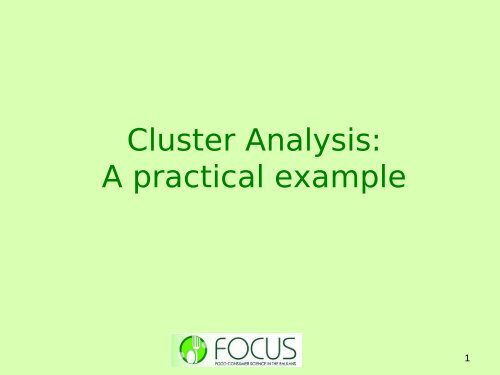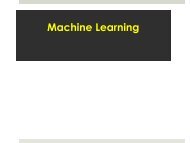Artificial Intelligence Course
Artificial Intelligence (AI) is the big thing in the technology field and a large number of organizations are implementing AI and the demand for professionals in AI is growing at an amazing speed. Artificial Intelligence (AI) course with ExcelR will provide a wide understanding of the concepts of Artificial Intelligence (AI) to make computer programs to solve problems and achieve goals in the world.
Artificial Intelligence (AI) is the big thing in the technology field and a large number of organizations are implementing AI and the demand for professionals in AI is growing at an amazing speed. Artificial Intelligence (AI) course with ExcelR will provide a wide understanding of the concepts of Artificial Intelligence (AI) to make computer programs to solve problems and achieve goals in the world.
You also want an ePaper? Increase the reach of your titles
YUMPU automatically turns print PDFs into web optimized ePapers that Google loves.
Cluster Analysis:<br />
A practical example<br />
1
Content<br />
Introduction: the necessity to reduce the<br />
complexity<br />
Recall: what cluster analysis does<br />
An example : cluster analysis in consumer<br />
research on fair trade coffee<br />
Discussion<br />
2
Intro<br />
(…)<br />
“Where is the life, we have lost in living?<br />
Where is the wisdom, we have lost in knowledge?<br />
Where is the knowledge, we have lost in information?”<br />
(…)<br />
T. S. Elliot,<br />
Choruses from the Rock<br />
(1888 – 1965)
Intro<br />
(…)<br />
Where is the wisdom, we have lost in knowledge?<br />
Where is the knowledge, we have lost in information?<br />
(…)<br />
“Where is the information we have lost in data?”
Intro<br />
In order to go from data to information, to<br />
knowledge and to wisdom,<br />
we need to reduce the complexity of the data.<br />
Complexity can be reduced on<br />
- case level : cluster analysis<br />
- on variable level: factor analysis
What cluster analysis does<br />
Cluster analysis can get you from this:<br />
a<br />
b<br />
c<br />
d<br />
e<br />
f<br />
To this:
What cluster analysis does<br />
Cluster analysis<br />
• generate groups which are similar<br />
• homogeneous within the group and as much as<br />
possible heterogeneous to other groups<br />
• data consists usually of objects or persons<br />
• segmentation based on more than two variables
What cluster analysis does<br />
Cluster analysis<br />
• generates groups which are similar<br />
• the groups are homogeneous within themselves<br />
and as much as possible heterogeneous to other<br />
groups<br />
• data consists usually of objects or persons<br />
• segmentation is based on more than two<br />
variables
What cluster analysis does<br />
Examples for datasets used for cluster<br />
analysis:<br />
• socio-economic criteria: income, education, profession,<br />
age, number of children, size of city of residence ....<br />
• psychographic criteria: interest, life style, motivation,<br />
values, involvement<br />
• criteria linked to the buying behaviour: price range, type<br />
of media used, intensity of use, choice of retail outlet,<br />
fidelity, buyer/non-buyer, buying intensity
What cluster analysis does<br />
Proximity Measures<br />
• Proximity measures are used to represent the nearness of two<br />
objects<br />
• relate objects with a high similarity to the same cluster and objects<br />
with low similarity to different clusters<br />
• differentiation of nominal-scaled and metric-scaled variables<br />
m<br />
d(y i<br />
,y s<br />
) = [∑ |y ij<br />
-y sj<br />
| r ]1/r<br />
y = vector<br />
j=1<br />
i,s = different objects<br />
j = the different characteristics<br />
r = changes the weight of assigned distances<br />
the calculation of the distances measures is the basis of the<br />
cluster analysis.
What cluster analysis does<br />
Two phases:<br />
1. Forming of clusters by the chosen data set – resulting<br />
in a new variable that identifies cluster members<br />
among the cases<br />
2. Description of clusters by re-crossing with the data
What cluster analysis does<br />
Cluster Algorithm in agglomerative hierarchical<br />
clustering methods – seven steps to get clusters<br />
1. each object is a independent cluster, n<br />
2. two clusters with the lowest distance are merged to<br />
one cluster. reduce the number of clusters by 1 (n-1)<br />
3. calculate the the distance matrix between the new<br />
cluster and all remaining clusters<br />
4. repeat step 2 and 3, (n-1) times until all objects form<br />
one reminding cluster
What cluster analysis does<br />
Finally…<br />
1. decide upon the number of clusters you want to keep<br />
(decision often based on the size of the clusters)<br />
2. description of the clusters by means of the clusterforming<br />
variables<br />
3. appellation of the clusters with catchy titles
What cluster analysis does<br />
Cluster 1<br />
Cluster 2<br />
Cluster 3<br />
Cluster 4<br />
Cluster 5
Practical Example<br />
Consumers and Fair Trade Coffee (1997!)<br />
214 interviews of consumers of fair trade<br />
coffee (personal and telephone interviews)<br />
Cluster analysis in order to identify consumer<br />
typologies<br />
Identification of 6 clusters<br />
Description of these clusters by further<br />
analysis: comparison of means, crosstabs etc.
Consumers and Fair Trade Coffee<br />
Description of clusters:<br />
Cluster 1 (11,6%): “self-oriented fair trade buyer”<br />
Cluster 2 (13,6%): “less ready to take personal<br />
constraints”<br />
Cluster 3 (18,2%): ”less engaged about fair trade”<br />
Cluster 4 (32,2%): “intensive buyer”<br />
Cluster 5 (18,7%): “value-oriented”<br />
Cluster 6 (5,6%): “does not like the taste of fair trade<br />
coffee”
Consumers and Fair Trade Coffee<br />
Description of Cluster 1 (11,6%): “self-oriented fair trade<br />
buyer” :<br />
Searches satisfaction by doing the good thing<br />
Is not altruistic<br />
Buys occasionally<br />
Sticks to his conventional coffee brand<br />
High level of formal education<br />
Frequently religious (catholic or protestant)
Consumers and Fair Trade Coffee<br />
Description of Cluster 2 (13,6%): “less ready to take<br />
personal constraints”<br />
States that “fair trade coffee is hard to find”<br />
Feels responsible for fare development issues<br />
Believes that fair trade is efficient for developing<br />
countries<br />
Is less ready to go to special fair trade outlets<br />
Buys conventional coffee<br />
Likes the taste of fair trade coffee
Consumers and Fair Trade Coffee<br />
Description of clusters Cluster 3 (18,2%): ”less engaged<br />
about fair trade” :<br />
Feels no personal responsibility with regard to<br />
development questions<br />
Doesn’t see the efficiency of the consumption of fair<br />
trade goods<br />
The only thing that can make him change is the<br />
influence of friends<br />
Is older then the average fair trade buyer and has less<br />
formal education
Consumers and Fair Trade Coffee<br />
Description of clusters: Cluster 4 (32,2%): “intensive<br />
buyer”<br />
Has abandoned conventional coffee brands<br />
Has started to buy fair trade quite a while ago (> 3<br />
years)<br />
Shops frequently in fair trade stores (and not in organic<br />
retail)<br />
Is ready to act for fair development and talks to friends<br />
about it<br />
Relatively young, with low incomes and high<br />
educational values
Consumers and Fair Trade Coffee<br />
Description of clusters: Cluster 5 (18,7%): “valueoriented”<br />
Together with cluster 4 highly aware of development<br />
issues<br />
Ready to act and to constraint consumption habits<br />
Buys for altruistic reasons<br />
Highly involved in social / political action<br />
Most frequently women, highest household income<br />
among all clusters<br />
Own security is the basis for solidary action
Consumers and Fair Trade Coffee<br />
Description of clusters: Cluster 6 (5,6%): “does not like<br />
the taste of fair trade coffee”<br />
Lowest purchase intensity of all clusters<br />
Not willing to accept constraints in consumption habits<br />
or higher prices<br />
Most members of these group are attached to a<br />
conventional coffee brand<br />
Relatively high incomes, age within the average of all<br />
groups, lower level of formal education<br />
Less religious than other groups.
Conclusion /<br />
Advantages<br />
discussion<br />
• no special scales of measurement necessary<br />
• high persuasiveness and good assignment to realisable<br />
recommendations in practice<br />
Disadvantages<br />
• choice of cluster-forming variables often not based on<br />
theory but at random<br />
• determination of the right number of clusters often timeconsuming<br />
– often decided upon arbitrarily<br />
• high influence on the interpretation of the scientist, difficult<br />
to control (good documentation is needed)
Conclusion /<br />
discussion
Sources<br />
Russell .L. Ackoff, "From Data to Wisdom," Journal of Applied Systems<br />
Analysis 16 (1989): 3-9.<br />
Milan Zeleny, "Management Support Systems: Towards Integrated<br />
Knowledge Management," Human Systems Management 7, no 1<br />
(1987): 59-70.<br />
Tashakkori, A. and Ch. Teddlie: Combining Qualitative and Quantitaive<br />
Approaches. Applied Social Research Methods Series, Volume 46.<br />
Thousand Oaks, London, New Delhi, 1998.<br />
xyxy








